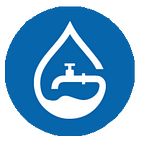www.watersecuritysystem.com
Miami’s Water: Water all around, but not a drop to drink
The importance to reduce our household water consumption beyond to save money
As strange as it sounds, the capital city of the ‘Sunshine State’ is also one of the top 10 rainiest cities in mainland USA, averaging 62 inches of rainfall per year. Stranger still is the fact that despite all this rain, Miami faces increasing water scarcity, threatening the water supply of the 6.1 million people living in Miami metropolitan area. Even more bizarre is the fact that this scarcity is partially driven by an excess of water — seawater.
Miami’s water supply comes primarily from the Biscayne aquifer, a shallow coastal aquifer of approximately 4,000 square miles, located below the city. It is made of porous limestone with tiny cracks and holes that allow rainwater to percolate through the ground and enter the aquifer. However, the city’s expansion has simultaneously increased the water demand and decreased the capacity of the ground to absorb the rainfall and replenish the aquifer. The former is a simple issue — a growing population increases the demand for water, and as well as water-intensive goods and services (energy, housing, food). The latter is due to urban sealing, whereby the permeable ground is covered by tarmac and concrete, preventing the water from trickling down into the aquifer. The result is the lowering of the water table of the Biscayne aquifer, leaving it vulnerable to saltwater intrusion, contaminating the aquifer and making the water unfit for human consumption.
Saltwater intrusion in the Biscayne aquifer dates back to the turn of the 20th century, when the first increase in salinity levels was reported, and continued unabated until the construction of salinity-control structures began in the mid-1940s. This process has been further exacerbated by the rising sea level, which is 9 inches higher than in 1930 and contributes to the storm surges and flash flooding that have been increasing in Miami in the last few decades.
During the rainy season, with constant thunderstorms and regular flooding — and particularly following Hurricane Elsa — it’s hard to imagine that Miami faces a water supply crisis. For the city’s residents, the impacts of flooded basements and waterlogged building foundations are — literally — much closer to home than more distant issues such as future water security, which is put on the back burner. However, as these threats to water security increasingly put the wellbeing of Miami’s residents at risk, it is crucial that everyone collaborates and works towards the shared goal of water conservation.
Fortunately — with over 100 years of experience — Florida’s water management has improved significantly, having faced issues such as hurricanes and flooding in addition to growing water demands, all of which have required the development of a solid water governance apparatus that puts water security at the forefront of their planning. The South Florida Water Management District (SFWMD), established in 2000, is responsible for protecting the district’s residents from flooding — in collaboration with country and city governments — as well as for safeguarding water resources to meet the demands of the 21 million people they serve, and restoring and protecting the ecosystems upon which water supplies rely.
At the individual level, there are many steps we can take to reduce out water footprint and protect our precious water resources through our daily actions. In fact, with this being one of the priorities of the SFWMD, per capita water consumption has reduced by almost 30% in the last 20 years. Today, there are plenty solutions available to reduce our household water consumption, including our state-of-art products that detect water leaks, thus mitigating water loss and associated damages. Not only do these technologies support household water conservation, but when combined with water efficiency efforts at the district and state level, they contribute to ensuring collective water security today, and safeguarding it for the future.
Immediate Leak Response Technology
One of the most innovative characteristics of the Water Security System is the immediate response it provides to water emergencies, big and small. When the system detects a leak — down to dripping precision — it will immediately send you a notification, either in the form of a text message, an email, or both. When a leak is detected, the system protects your home from water damage and potential flooding by automatically shutting off the main water supply.
Sensor Based
Because the AC condenser water is a separate piping system, it must be monitored independently of the domestic system. The water sensor will be placed on the floor to detect and notify in case of any leak from AC unit. Other sensors can be placed near appliances to detect immediately any hose burst or water on the floor. Automatic shut-off is provided in case of flooding, leak or improper use of potable water. The water main can also be automatically closed or open from the property owner/tenant app and/or the property manager dashboard, with the command priority from the property manager. Many insurance companies will give a discount if a flood protection system includes an automatic shut-off device.
As an industry leader, Water Security System helps homes of any size save water, prevent damage, and save money. As a global entity, we are well aware of the importance of water conservation. With both a greater understanding of water usage and a system that protects your home from water damage, you can save money on your water bill. The Water Security System works around the clock to benefit its users, through innovation and ease of use.
About Us | Our Products | Contact Us | LinkedIn | Instagram
